Analyzing Cross-Cultural Business with Hofstede's Model: A Case Study
VerifiedAdded on 2023/06/14
|25
|6134
|278
Essay
AI Summary
This essay provides a critical assessment of Hofstede's model of national culture, examining its strengths, weaknesses, and relevance in the context of modern cross-border business development. It summarizes the six dimensions of Hofstede's model: Power Distance, Individualism/Collectivism, Masculinity/Femininity, Uncertainty Avoidance, Long/Short Term Orientation, and Indulgence/Restraint, explaining how each dimension influences organizational behavior and international business strategies. The essay also addresses common criticisms of the model, particularly concerning its methodology and applicability in a globalized world, while referencing alternative models like Trompenaars and the GLOBE project. Furthermore, the analysis includes a case study of Burberry's expansion into India, illustrating how national cultural differences can impact business outcomes. The essay concludes by discussing how individual behavior can be adapted to enhance success in cross-border business ventures.
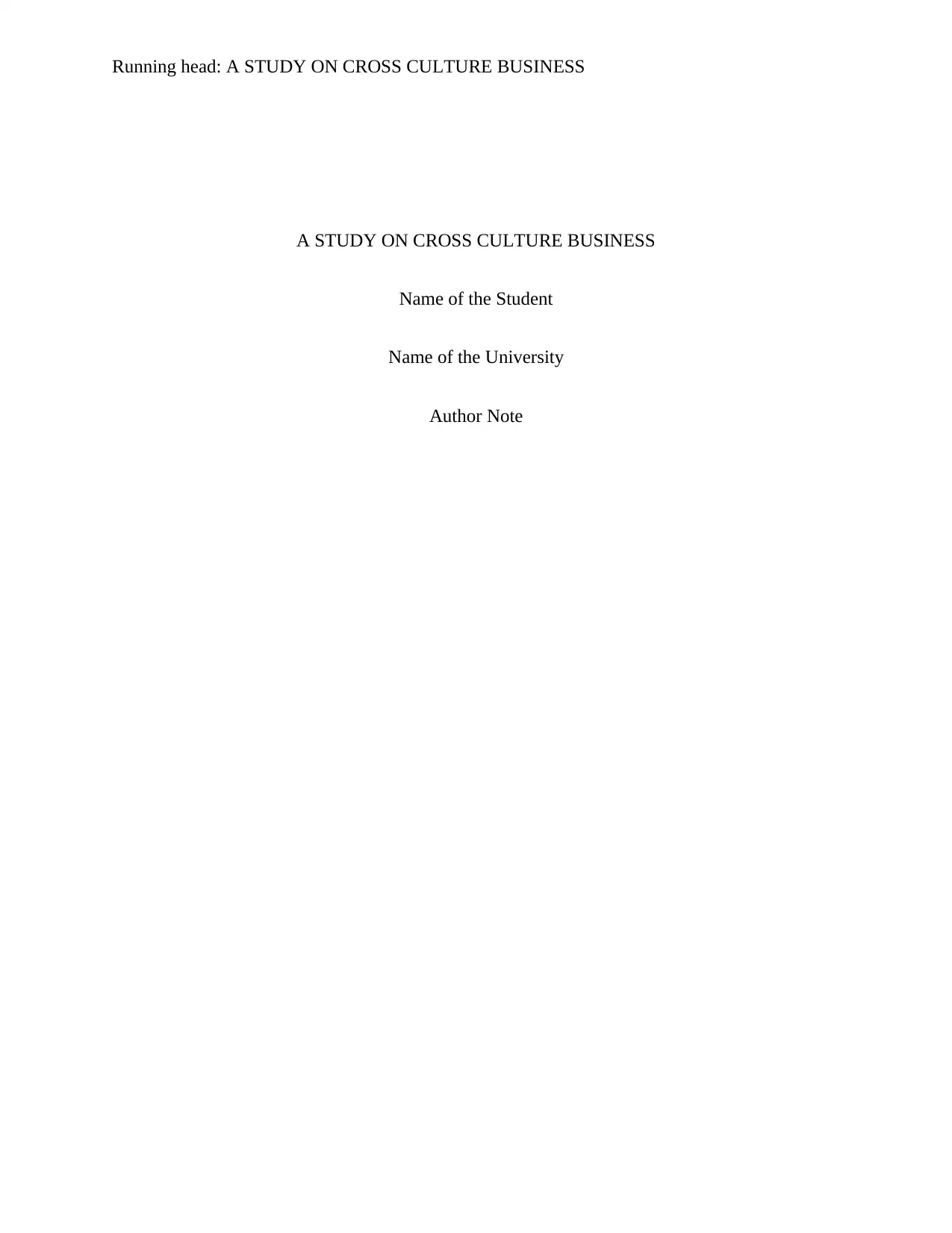
Running head: A STUDY ON CROSS CULTURE BUSINESS
A STUDY ON CROSS CULTURE BUSINESS
Name of the Student
Name of the University
Author Note
A STUDY ON CROSS CULTURE BUSINESS
Name of the Student
Name of the University
Author Note
Paraphrase This Document
Need a fresh take? Get an instant paraphrase of this document with our AI Paraphraser
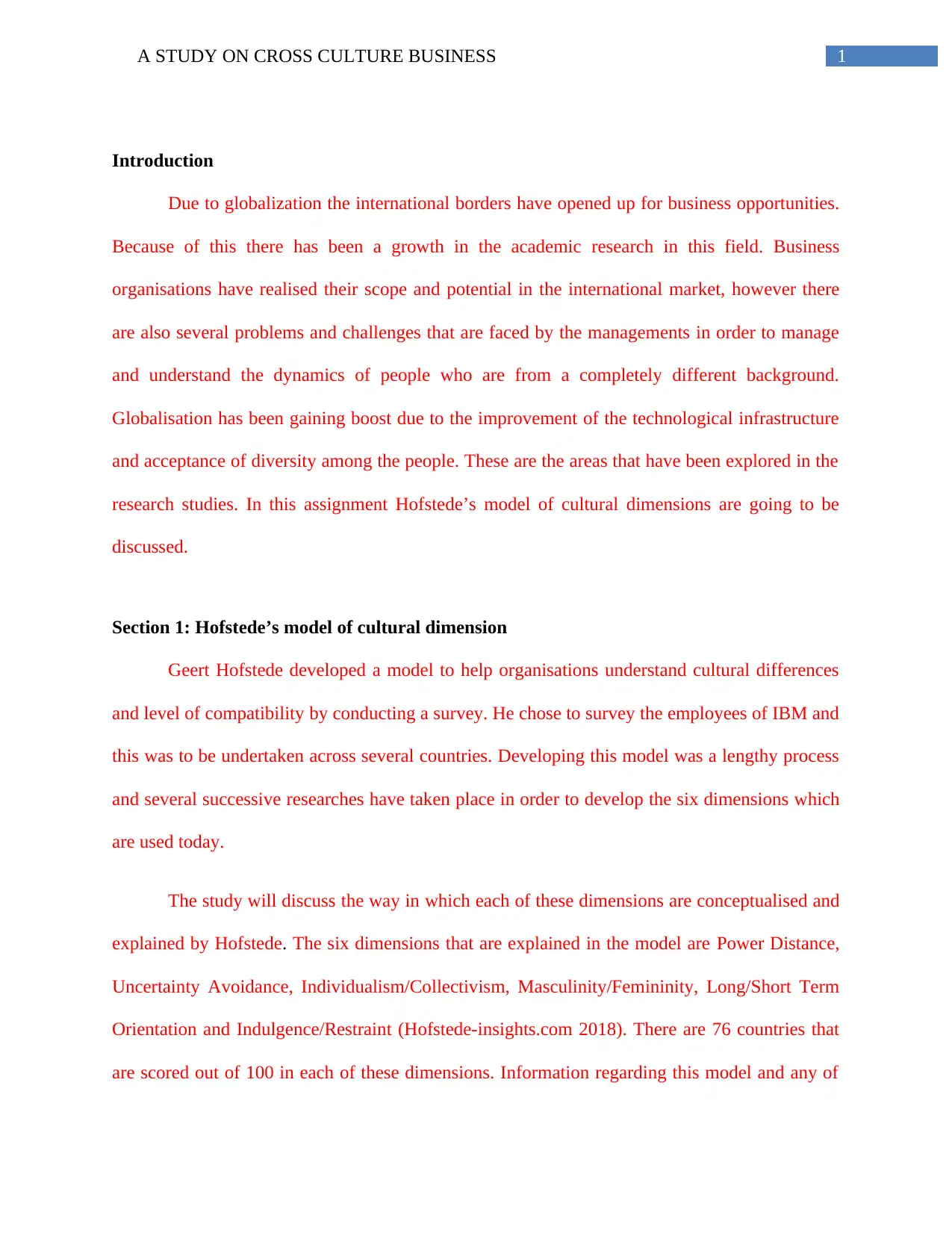
1A STUDY ON CROSS CULTURE BUSINESS
Introduction
Due to globalization the international borders have opened up for business opportunities.
Because of this there has been a growth in the academic research in this field. Business
organisations have realised their scope and potential in the international market, however there
are also several problems and challenges that are faced by the managements in order to manage
and understand the dynamics of people who are from a completely different background.
Globalisation has been gaining boost due to the improvement of the technological infrastructure
and acceptance of diversity among the people. These are the areas that have been explored in the
research studies. In this assignment Hofstede’s model of cultural dimensions are going to be
discussed.
Section 1: Hofstede’s model of cultural dimension
Geert Hofstede developed a model to help organisations understand cultural differences
and level of compatibility by conducting a survey. He chose to survey the employees of IBM and
this was to be undertaken across several countries. Developing this model was a lengthy process
and several successive researches have taken place in order to develop the six dimensions which
are used today.
The study will discuss the way in which each of these dimensions are conceptualised and
explained by Hofstede. The six dimensions that are explained in the model are Power Distance,
Uncertainty Avoidance, Individualism/Collectivism, Masculinity/Femininity, Long/Short Term
Orientation and Indulgence/Restraint (Hofstede-insights.com 2018). There are 76 countries that
are scored out of 100 in each of these dimensions. Information regarding this model and any of
Introduction
Due to globalization the international borders have opened up for business opportunities.
Because of this there has been a growth in the academic research in this field. Business
organisations have realised their scope and potential in the international market, however there
are also several problems and challenges that are faced by the managements in order to manage
and understand the dynamics of people who are from a completely different background.
Globalisation has been gaining boost due to the improvement of the technological infrastructure
and acceptance of diversity among the people. These are the areas that have been explored in the
research studies. In this assignment Hofstede’s model of cultural dimensions are going to be
discussed.
Section 1: Hofstede’s model of cultural dimension
Geert Hofstede developed a model to help organisations understand cultural differences
and level of compatibility by conducting a survey. He chose to survey the employees of IBM and
this was to be undertaken across several countries. Developing this model was a lengthy process
and several successive researches have taken place in order to develop the six dimensions which
are used today.
The study will discuss the way in which each of these dimensions are conceptualised and
explained by Hofstede. The six dimensions that are explained in the model are Power Distance,
Uncertainty Avoidance, Individualism/Collectivism, Masculinity/Femininity, Long/Short Term
Orientation and Indulgence/Restraint (Hofstede-insights.com 2018). There are 76 countries that
are scored out of 100 in each of these dimensions. Information regarding this model and any of
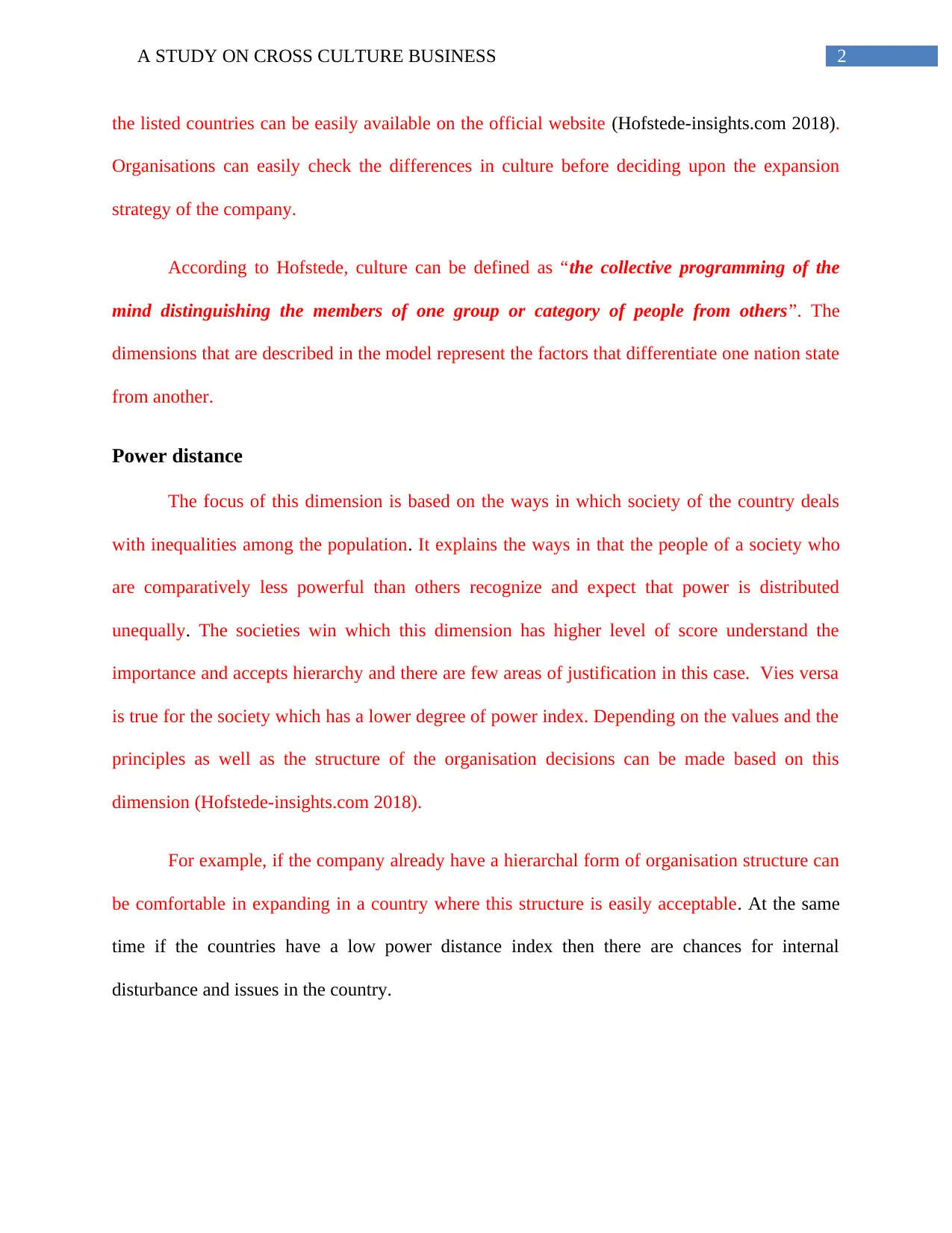
2A STUDY ON CROSS CULTURE BUSINESS
the listed countries can be easily available on the official website (Hofstede-insights.com 2018).
Organisations can easily check the differences in culture before deciding upon the expansion
strategy of the company.
According to Hofstede, culture can be defined as “the collective programming of the
mind distinguishing the members of one group or category of people from others”. The
dimensions that are described in the model represent the factors that differentiate one nation state
from another.
Power distance
The focus of this dimension is based on the ways in which society of the country deals
with inequalities among the population. It explains the ways in that the people of a society who
are comparatively less powerful than others recognize and expect that power is distributed
unequally. The societies win which this dimension has higher level of score understand the
importance and accepts hierarchy and there are few areas of justification in this case. Vies versa
is true for the society which has a lower degree of power index. Depending on the values and the
principles as well as the structure of the organisation decisions can be made based on this
dimension (Hofstede-insights.com 2018).
For example, if the company already have a hierarchal form of organisation structure can
be comfortable in expanding in a country where this structure is easily acceptable. At the same
time if the countries have a low power distance index then there are chances for internal
disturbance and issues in the country.
the listed countries can be easily available on the official website (Hofstede-insights.com 2018).
Organisations can easily check the differences in culture before deciding upon the expansion
strategy of the company.
According to Hofstede, culture can be defined as “the collective programming of the
mind distinguishing the members of one group or category of people from others”. The
dimensions that are described in the model represent the factors that differentiate one nation state
from another.
Power distance
The focus of this dimension is based on the ways in which society of the country deals
with inequalities among the population. It explains the ways in that the people of a society who
are comparatively less powerful than others recognize and expect that power is distributed
unequally. The societies win which this dimension has higher level of score understand the
importance and accepts hierarchy and there are few areas of justification in this case. Vies versa
is true for the society which has a lower degree of power index. Depending on the values and the
principles as well as the structure of the organisation decisions can be made based on this
dimension (Hofstede-insights.com 2018).
For example, if the company already have a hierarchal form of organisation structure can
be comfortable in expanding in a country where this structure is easily acceptable. At the same
time if the countries have a low power distance index then there are chances for internal
disturbance and issues in the country.
⊘ This is a preview!⊘
Do you want full access?
Subscribe today to unlock all pages.

Trusted by 1+ million students worldwide
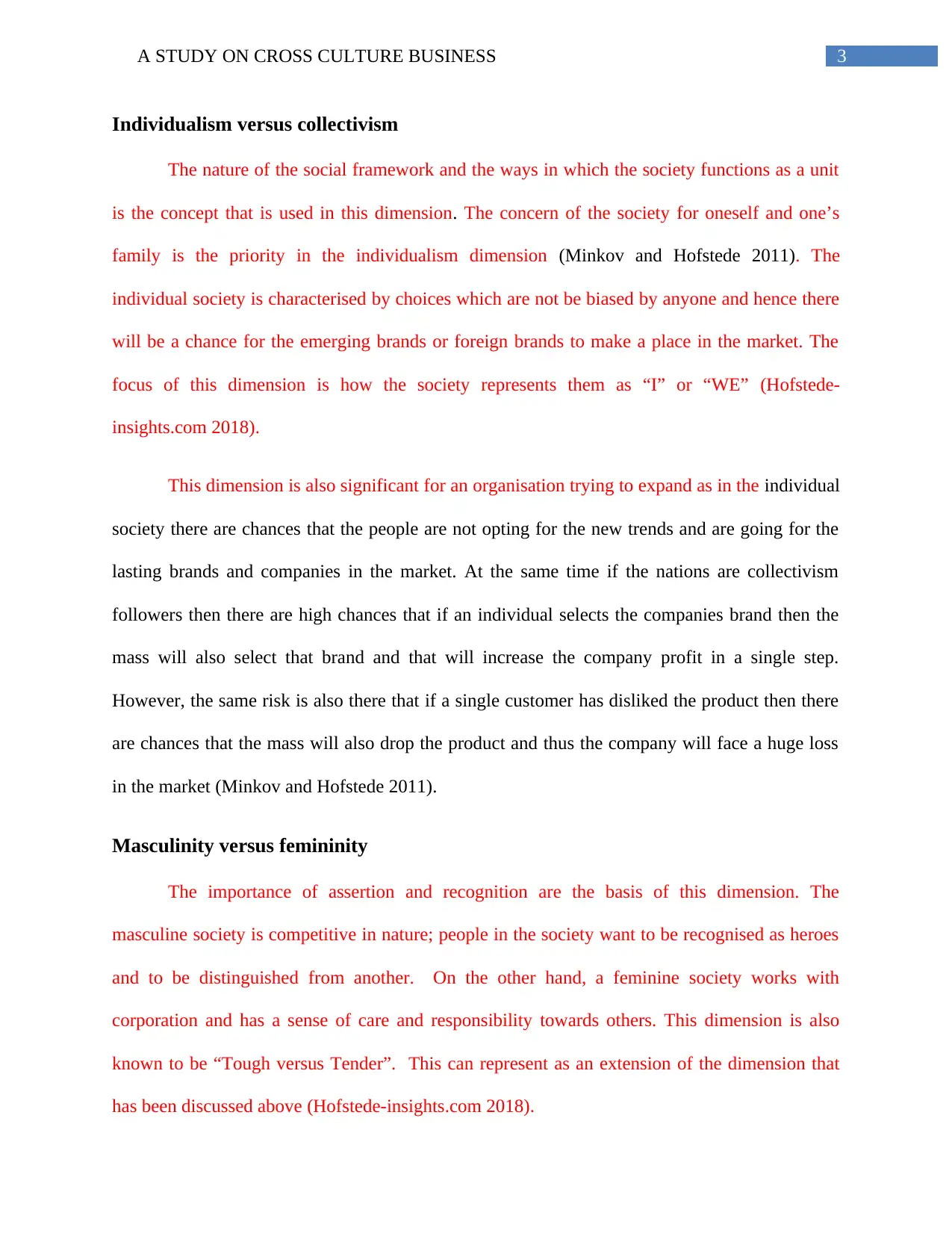
3A STUDY ON CROSS CULTURE BUSINESS
Individualism versus collectivism
The nature of the social framework and the ways in which the society functions as a unit
is the concept that is used in this dimension. The concern of the society for oneself and one’s
family is the priority in the individualism dimension (Minkov and Hofstede 2011). The
individual society is characterised by choices which are not be biased by anyone and hence there
will be a chance for the emerging brands or foreign brands to make a place in the market. The
focus of this dimension is how the society represents them as “I” or “WE” (Hofstede-
insights.com 2018).
This dimension is also significant for an organisation trying to expand as in the individual
society there are chances that the people are not opting for the new trends and are going for the
lasting brands and companies in the market. At the same time if the nations are collectivism
followers then there are high chances that if an individual selects the companies brand then the
mass will also select that brand and that will increase the company profit in a single step.
However, the same risk is also there that if a single customer has disliked the product then there
are chances that the mass will also drop the product and thus the company will face a huge loss
in the market (Minkov and Hofstede 2011).
Masculinity versus femininity
The importance of assertion and recognition are the basis of this dimension. The
masculine society is competitive in nature; people in the society want to be recognised as heroes
and to be distinguished from another. On the other hand, a feminine society works with
corporation and has a sense of care and responsibility towards others. This dimension is also
known to be “Tough versus Tender”. This can represent as an extension of the dimension that
has been discussed above (Hofstede-insights.com 2018).
Individualism versus collectivism
The nature of the social framework and the ways in which the society functions as a unit
is the concept that is used in this dimension. The concern of the society for oneself and one’s
family is the priority in the individualism dimension (Minkov and Hofstede 2011). The
individual society is characterised by choices which are not be biased by anyone and hence there
will be a chance for the emerging brands or foreign brands to make a place in the market. The
focus of this dimension is how the society represents them as “I” or “WE” (Hofstede-
insights.com 2018).
This dimension is also significant for an organisation trying to expand as in the individual
society there are chances that the people are not opting for the new trends and are going for the
lasting brands and companies in the market. At the same time if the nations are collectivism
followers then there are high chances that if an individual selects the companies brand then the
mass will also select that brand and that will increase the company profit in a single step.
However, the same risk is also there that if a single customer has disliked the product then there
are chances that the mass will also drop the product and thus the company will face a huge loss
in the market (Minkov and Hofstede 2011).
Masculinity versus femininity
The importance of assertion and recognition are the basis of this dimension. The
masculine society is competitive in nature; people in the society want to be recognised as heroes
and to be distinguished from another. On the other hand, a feminine society works with
corporation and has a sense of care and responsibility towards others. This dimension is also
known to be “Tough versus Tender”. This can represent as an extension of the dimension that
has been discussed above (Hofstede-insights.com 2018).
Paraphrase This Document
Need a fresh take? Get an instant paraphrase of this document with our AI Paraphraser
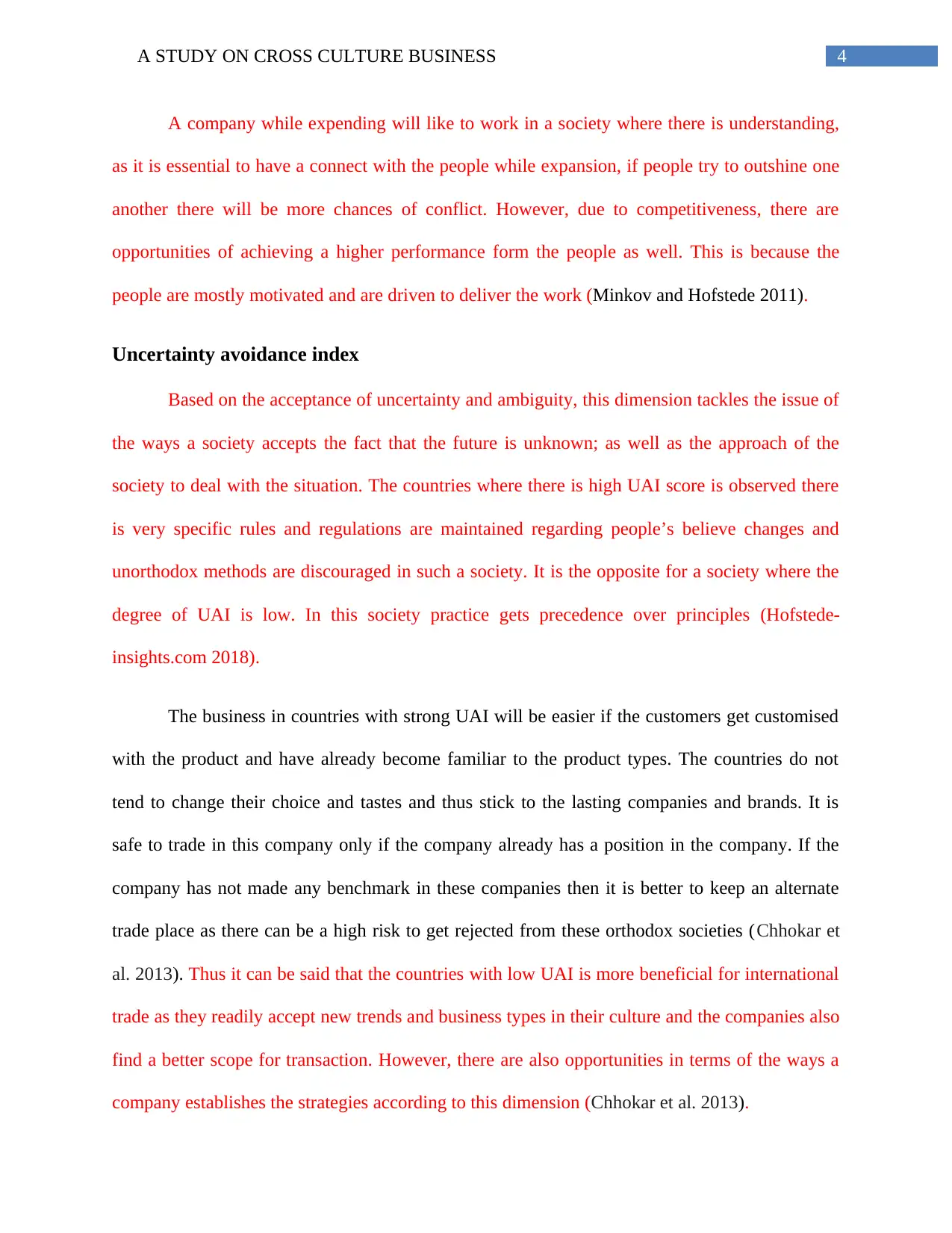
4A STUDY ON CROSS CULTURE BUSINESS
A company while expending will like to work in a society where there is understanding,
as it is essential to have a connect with the people while expansion, if people try to outshine one
another there will be more chances of conflict. However, due to competitiveness, there are
opportunities of achieving a higher performance form the people as well. This is because the
people are mostly motivated and are driven to deliver the work (Minkov and Hofstede 2011).
Uncertainty avoidance index
Based on the acceptance of uncertainty and ambiguity, this dimension tackles the issue of
the ways a society accepts the fact that the future is unknown; as well as the approach of the
society to deal with the situation. The countries where there is high UAI score is observed there
is very specific rules and regulations are maintained regarding people’s believe changes and
unorthodox methods are discouraged in such a society. It is the opposite for a society where the
degree of UAI is low. In this society practice gets precedence over principles (Hofstede-
insights.com 2018).
The business in countries with strong UAI will be easier if the customers get customised
with the product and have already become familiar to the product types. The countries do not
tend to change their choice and tastes and thus stick to the lasting companies and brands. It is
safe to trade in this company only if the company already has a position in the company. If the
company has not made any benchmark in these companies then it is better to keep an alternate
trade place as there can be a high risk to get rejected from these orthodox societies (Chhokar et
al. 2013). Thus it can be said that the countries with low UAI is more beneficial for international
trade as they readily accept new trends and business types in their culture and the companies also
find a better scope for transaction. However, there are also opportunities in terms of the ways a
company establishes the strategies according to this dimension (Chhokar et al. 2013).
A company while expending will like to work in a society where there is understanding,
as it is essential to have a connect with the people while expansion, if people try to outshine one
another there will be more chances of conflict. However, due to competitiveness, there are
opportunities of achieving a higher performance form the people as well. This is because the
people are mostly motivated and are driven to deliver the work (Minkov and Hofstede 2011).
Uncertainty avoidance index
Based on the acceptance of uncertainty and ambiguity, this dimension tackles the issue of
the ways a society accepts the fact that the future is unknown; as well as the approach of the
society to deal with the situation. The countries where there is high UAI score is observed there
is very specific rules and regulations are maintained regarding people’s believe changes and
unorthodox methods are discouraged in such a society. It is the opposite for a society where the
degree of UAI is low. In this society practice gets precedence over principles (Hofstede-
insights.com 2018).
The business in countries with strong UAI will be easier if the customers get customised
with the product and have already become familiar to the product types. The countries do not
tend to change their choice and tastes and thus stick to the lasting companies and brands. It is
safe to trade in this company only if the company already has a position in the company. If the
company has not made any benchmark in these companies then it is better to keep an alternate
trade place as there can be a high risk to get rejected from these orthodox societies (Chhokar et
al. 2013). Thus it can be said that the countries with low UAI is more beneficial for international
trade as they readily accept new trends and business types in their culture and the companies also
find a better scope for transaction. However, there are also opportunities in terms of the ways a
company establishes the strategies according to this dimension (Chhokar et al. 2013).

5A STUDY ON CROSS CULTURE BUSINESS
⊘ This is a preview!⊘
Do you want full access?
Subscribe today to unlock all pages.

Trusted by 1+ million students worldwide
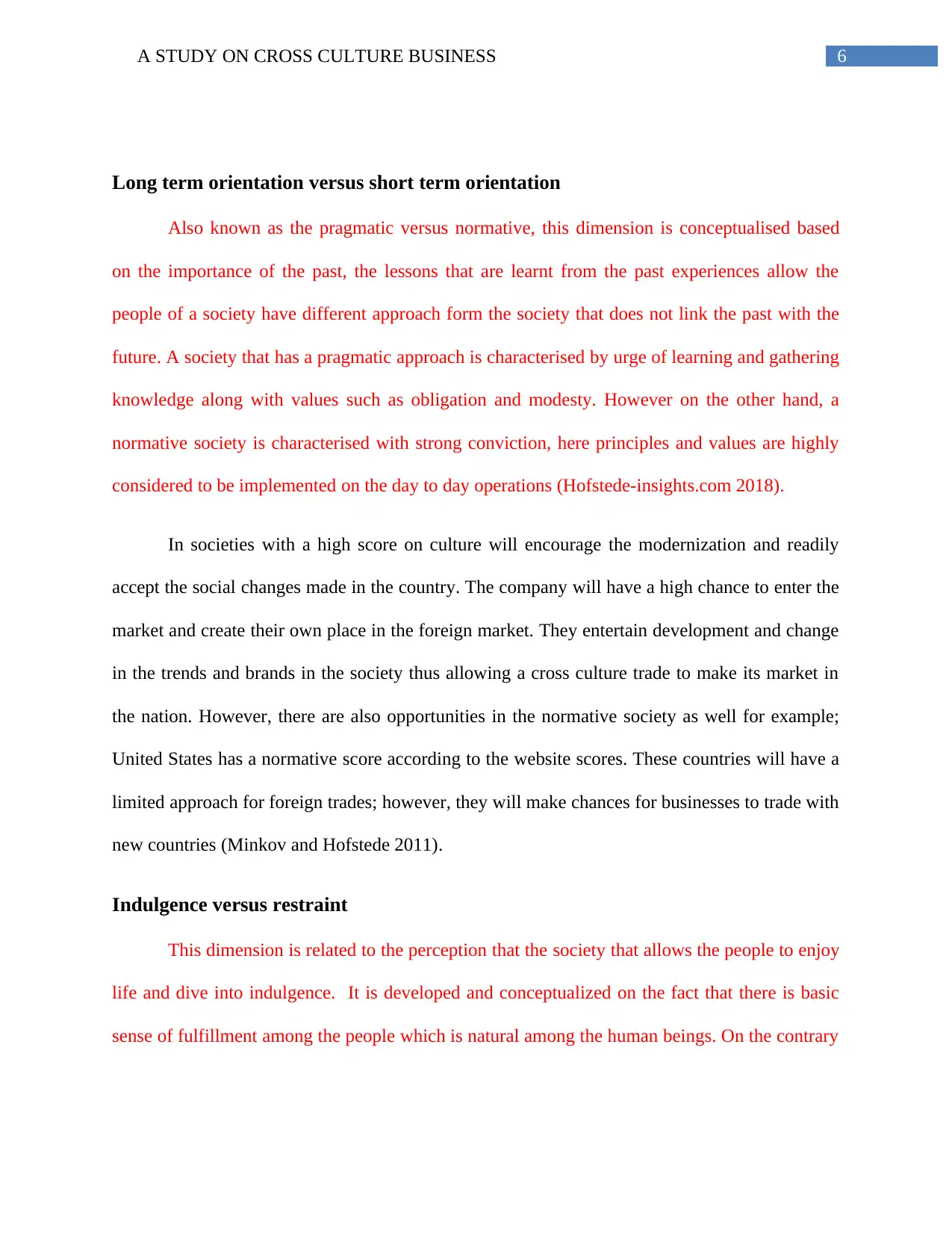
6A STUDY ON CROSS CULTURE BUSINESS
Long term orientation versus short term orientation
Also known as the pragmatic versus normative, this dimension is conceptualised based
on the importance of the past, the lessons that are learnt from the past experiences allow the
people of a society have different approach form the society that does not link the past with the
future. A society that has a pragmatic approach is characterised by urge of learning and gathering
knowledge along with values such as obligation and modesty. However on the other hand, a
normative society is characterised with strong conviction, here principles and values are highly
considered to be implemented on the day to day operations (Hofstede-insights.com 2018).
In societies with a high score on culture will encourage the modernization and readily
accept the social changes made in the country. The company will have a high chance to enter the
market and create their own place in the foreign market. They entertain development and change
in the trends and brands in the society thus allowing a cross culture trade to make its market in
the nation. However, there are also opportunities in the normative society as well for example;
United States has a normative score according to the website scores. These countries will have a
limited approach for foreign trades; however, they will make chances for businesses to trade with
new countries (Minkov and Hofstede 2011).
Indulgence versus restraint
This dimension is related to the perception that the society that allows the people to enjoy
life and dive into indulgence. It is developed and conceptualized on the fact that there is basic
sense of fulfillment among the people which is natural among the human beings. On the contrary
Long term orientation versus short term orientation
Also known as the pragmatic versus normative, this dimension is conceptualised based
on the importance of the past, the lessons that are learnt from the past experiences allow the
people of a society have different approach form the society that does not link the past with the
future. A society that has a pragmatic approach is characterised by urge of learning and gathering
knowledge along with values such as obligation and modesty. However on the other hand, a
normative society is characterised with strong conviction, here principles and values are highly
considered to be implemented on the day to day operations (Hofstede-insights.com 2018).
In societies with a high score on culture will encourage the modernization and readily
accept the social changes made in the country. The company will have a high chance to enter the
market and create their own place in the foreign market. They entertain development and change
in the trends and brands in the society thus allowing a cross culture trade to make its market in
the nation. However, there are also opportunities in the normative society as well for example;
United States has a normative score according to the website scores. These countries will have a
limited approach for foreign trades; however, they will make chances for businesses to trade with
new countries (Minkov and Hofstede 2011).
Indulgence versus restraint
This dimension is related to the perception that the society that allows the people to enjoy
life and dive into indulgence. It is developed and conceptualized on the fact that there is basic
sense of fulfillment among the people which is natural among the human beings. On the contrary
Paraphrase This Document
Need a fresh take? Get an instant paraphrase of this document with our AI Paraphraser
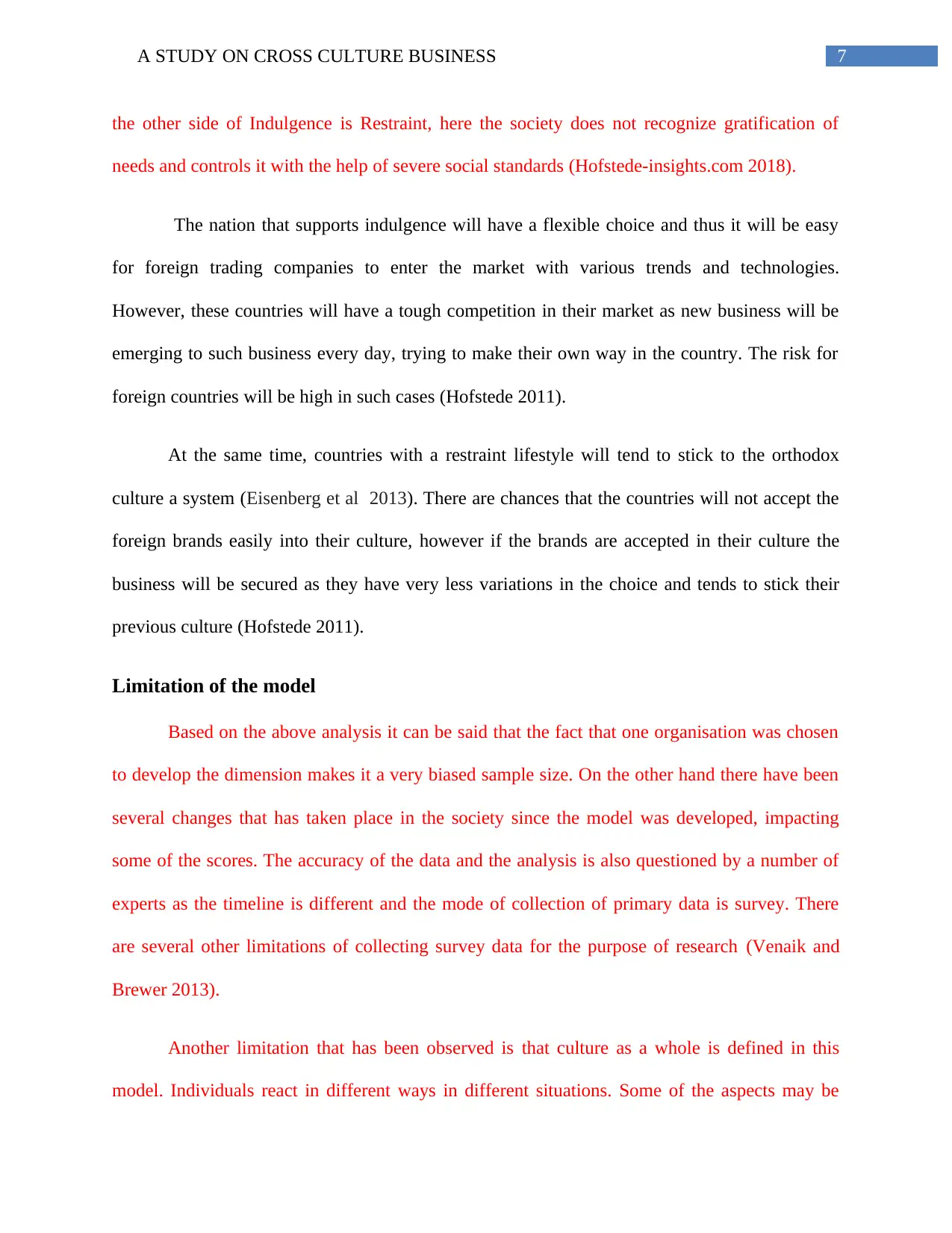
7A STUDY ON CROSS CULTURE BUSINESS
the other side of Indulgence is Restraint, here the society does not recognize gratification of
needs and controls it with the help of severe social standards (Hofstede-insights.com 2018).
The nation that supports indulgence will have a flexible choice and thus it will be easy
for foreign trading companies to enter the market with various trends and technologies.
However, these countries will have a tough competition in their market as new business will be
emerging to such business every day, trying to make their own way in the country. The risk for
foreign countries will be high in such cases (Hofstede 2011).
At the same time, countries with a restraint lifestyle will tend to stick to the orthodox
culture a system (Eisenberg et al 2013). There are chances that the countries will not accept the
foreign brands easily into their culture, however if the brands are accepted in their culture the
business will be secured as they have very less variations in the choice and tends to stick their
previous culture (Hofstede 2011).
Limitation of the model
Based on the above analysis it can be said that the fact that one organisation was chosen
to develop the dimension makes it a very biased sample size. On the other hand there have been
several changes that has taken place in the society since the model was developed, impacting
some of the scores. The accuracy of the data and the analysis is also questioned by a number of
experts as the timeline is different and the mode of collection of primary data is survey. There
are several other limitations of collecting survey data for the purpose of research (Venaik and
Brewer 2013).
Another limitation that has been observed is that culture as a whole is defined in this
model. Individuals react in different ways in different situations. Some of the aspects may be
the other side of Indulgence is Restraint, here the society does not recognize gratification of
needs and controls it with the help of severe social standards (Hofstede-insights.com 2018).
The nation that supports indulgence will have a flexible choice and thus it will be easy
for foreign trading companies to enter the market with various trends and technologies.
However, these countries will have a tough competition in their market as new business will be
emerging to such business every day, trying to make their own way in the country. The risk for
foreign countries will be high in such cases (Hofstede 2011).
At the same time, countries with a restraint lifestyle will tend to stick to the orthodox
culture a system (Eisenberg et al 2013). There are chances that the countries will not accept the
foreign brands easily into their culture, however if the brands are accepted in their culture the
business will be secured as they have very less variations in the choice and tends to stick their
previous culture (Hofstede 2011).
Limitation of the model
Based on the above analysis it can be said that the fact that one organisation was chosen
to develop the dimension makes it a very biased sample size. On the other hand there have been
several changes that has taken place in the society since the model was developed, impacting
some of the scores. The accuracy of the data and the analysis is also questioned by a number of
experts as the timeline is different and the mode of collection of primary data is survey. There
are several other limitations of collecting survey data for the purpose of research (Venaik and
Brewer 2013).
Another limitation that has been observed is that culture as a whole is defined in this
model. Individuals react in different ways in different situations. Some of the aspects may be
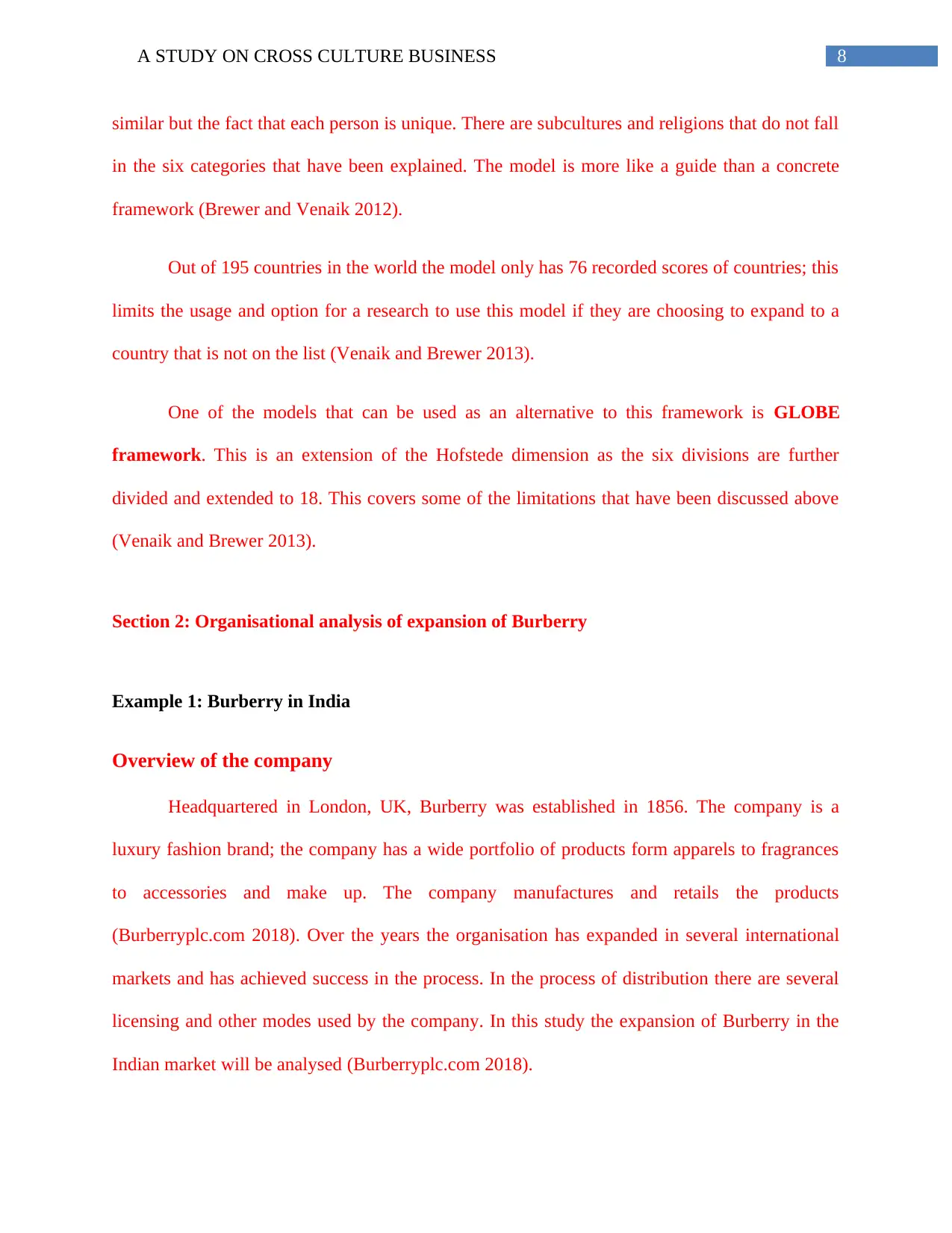
8A STUDY ON CROSS CULTURE BUSINESS
similar but the fact that each person is unique. There are subcultures and religions that do not fall
in the six categories that have been explained. The model is more like a guide than a concrete
framework (Brewer and Venaik 2012).
Out of 195 countries in the world the model only has 76 recorded scores of countries; this
limits the usage and option for a research to use this model if they are choosing to expand to a
country that is not on the list (Venaik and Brewer 2013).
One of the models that can be used as an alternative to this framework is GLOBE
framework. This is an extension of the Hofstede dimension as the six divisions are further
divided and extended to 18. This covers some of the limitations that have been discussed above
(Venaik and Brewer 2013).
Section 2: Organisational analysis of expansion of Burberry
Example 1: Burberry in India
Overview of the company
Headquartered in London, UK, Burberry was established in 1856. The company is a
luxury fashion brand; the company has a wide portfolio of products form apparels to fragrances
to accessories and make up. The company manufactures and retails the products
(Burberryplc.com 2018). Over the years the organisation has expanded in several international
markets and has achieved success in the process. In the process of distribution there are several
licensing and other modes used by the company. In this study the expansion of Burberry in the
Indian market will be analysed (Burberryplc.com 2018).
similar but the fact that each person is unique. There are subcultures and religions that do not fall
in the six categories that have been explained. The model is more like a guide than a concrete
framework (Brewer and Venaik 2012).
Out of 195 countries in the world the model only has 76 recorded scores of countries; this
limits the usage and option for a research to use this model if they are choosing to expand to a
country that is not on the list (Venaik and Brewer 2013).
One of the models that can be used as an alternative to this framework is GLOBE
framework. This is an extension of the Hofstede dimension as the six divisions are further
divided and extended to 18. This covers some of the limitations that have been discussed above
(Venaik and Brewer 2013).
Section 2: Organisational analysis of expansion of Burberry
Example 1: Burberry in India
Overview of the company
Headquartered in London, UK, Burberry was established in 1856. The company is a
luxury fashion brand; the company has a wide portfolio of products form apparels to fragrances
to accessories and make up. The company manufactures and retails the products
(Burberryplc.com 2018). Over the years the organisation has expanded in several international
markets and has achieved success in the process. In the process of distribution there are several
licensing and other modes used by the company. In this study the expansion of Burberry in the
Indian market will be analysed (Burberryplc.com 2018).
⊘ This is a preview!⊘
Do you want full access?
Subscribe today to unlock all pages.

Trusted by 1+ million students worldwide
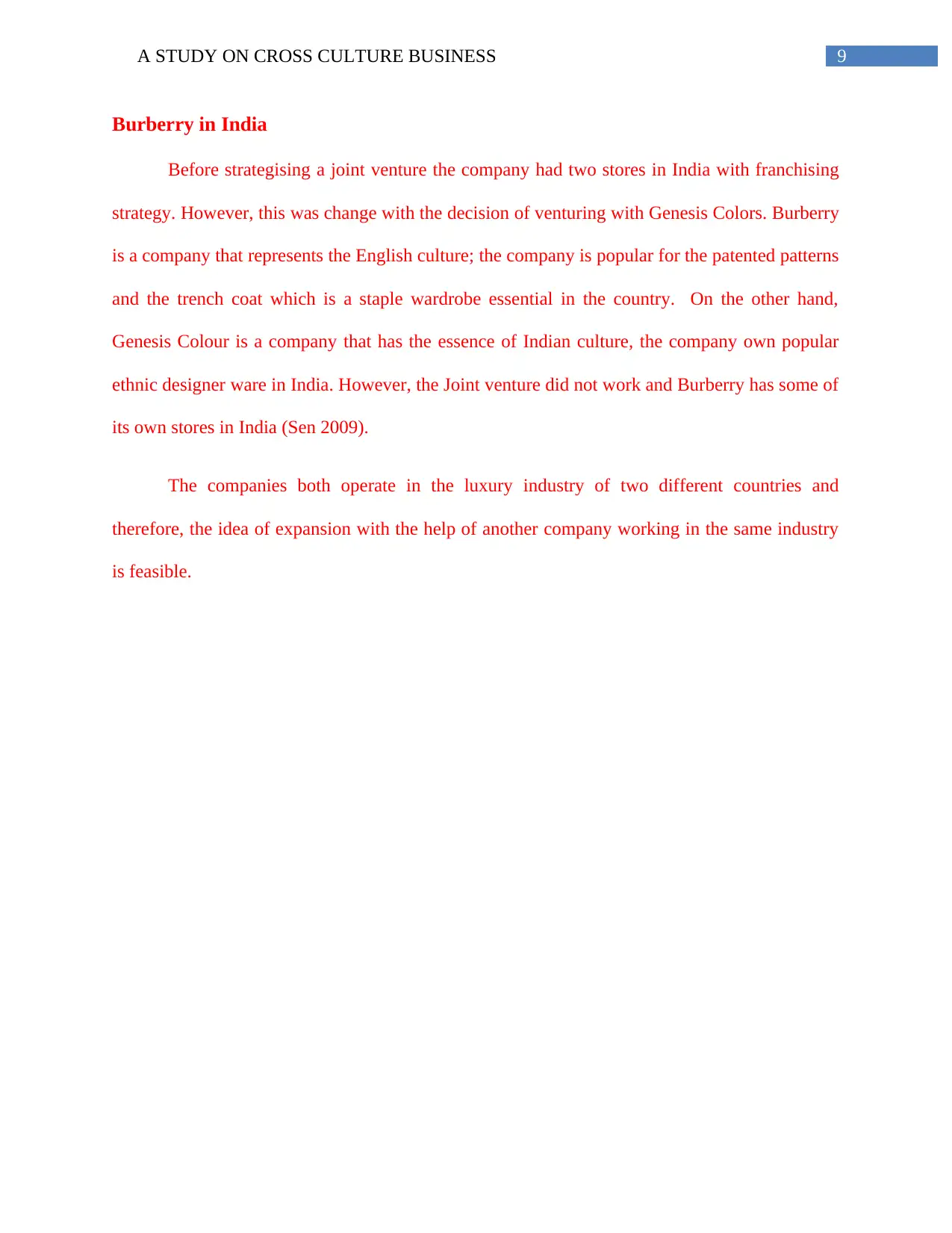
9A STUDY ON CROSS CULTURE BUSINESS
Burberry in India
Before strategising a joint venture the company had two stores in India with franchising
strategy. However, this was change with the decision of venturing with Genesis Colors. Burberry
is a company that represents the English culture; the company is popular for the patented patterns
and the trench coat which is a staple wardrobe essential in the country. On the other hand,
Genesis Colour is a company that has the essence of Indian culture, the company own popular
ethnic designer ware in India. However, the Joint venture did not work and Burberry has some of
its own stores in India (Sen 2009).
The companies both operate in the luxury industry of two different countries and
therefore, the idea of expansion with the help of another company working in the same industry
is feasible.
Burberry in India
Before strategising a joint venture the company had two stores in India with franchising
strategy. However, this was change with the decision of venturing with Genesis Colors. Burberry
is a company that represents the English culture; the company is popular for the patented patterns
and the trench coat which is a staple wardrobe essential in the country. On the other hand,
Genesis Colour is a company that has the essence of Indian culture, the company own popular
ethnic designer ware in India. However, the Joint venture did not work and Burberry has some of
its own stores in India (Sen 2009).
The companies both operate in the luxury industry of two different countries and
therefore, the idea of expansion with the help of another company working in the same industry
is feasible.
Paraphrase This Document
Need a fresh take? Get an instant paraphrase of this document with our AI Paraphraser
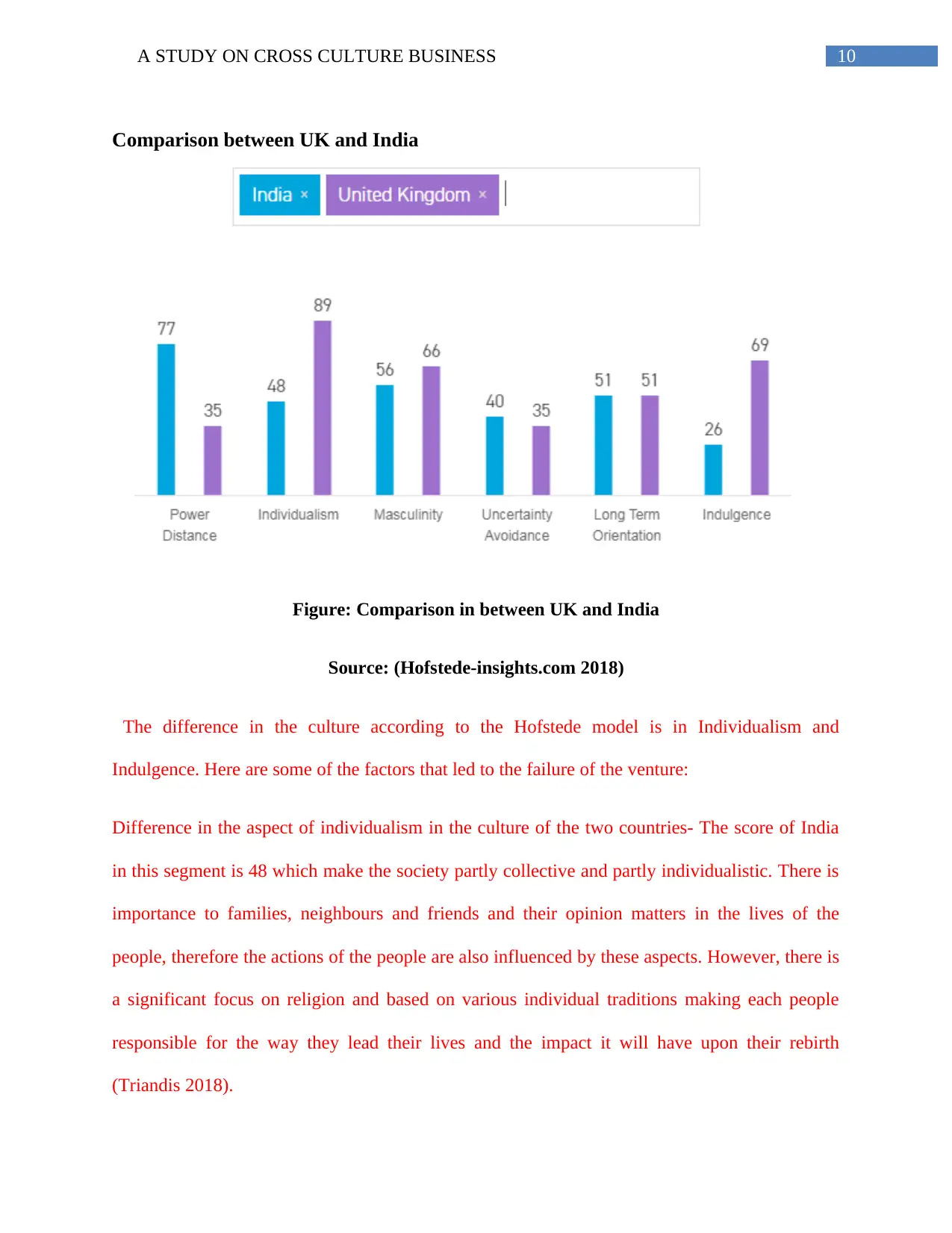
10A STUDY ON CROSS CULTURE BUSINESS
Comparison between UK and India
Figure: Comparison in between UK and India
Source: (Hofstede-insights.com 2018)
The difference in the culture according to the Hofstede model is in Individualism and
Indulgence. Here are some of the factors that led to the failure of the venture:
Difference in the aspect of individualism in the culture of the two countries- The score of India
in this segment is 48 which make the society partly collective and partly individualistic. There is
importance to families, neighbours and friends and their opinion matters in the lives of the
people, therefore the actions of the people are also influenced by these aspects. However, there is
a significant focus on religion and based on various individual traditions making each people
responsible for the way they lead their lives and the impact it will have upon their rebirth
(Triandis 2018).
Comparison between UK and India
Figure: Comparison in between UK and India
Source: (Hofstede-insights.com 2018)
The difference in the culture according to the Hofstede model is in Individualism and
Indulgence. Here are some of the factors that led to the failure of the venture:
Difference in the aspect of individualism in the culture of the two countries- The score of India
in this segment is 48 which make the society partly collective and partly individualistic. There is
importance to families, neighbours and friends and their opinion matters in the lives of the
people, therefore the actions of the people are also influenced by these aspects. However, there is
a significant focus on religion and based on various individual traditions making each people
responsible for the way they lead their lives and the impact it will have upon their rebirth
(Triandis 2018).
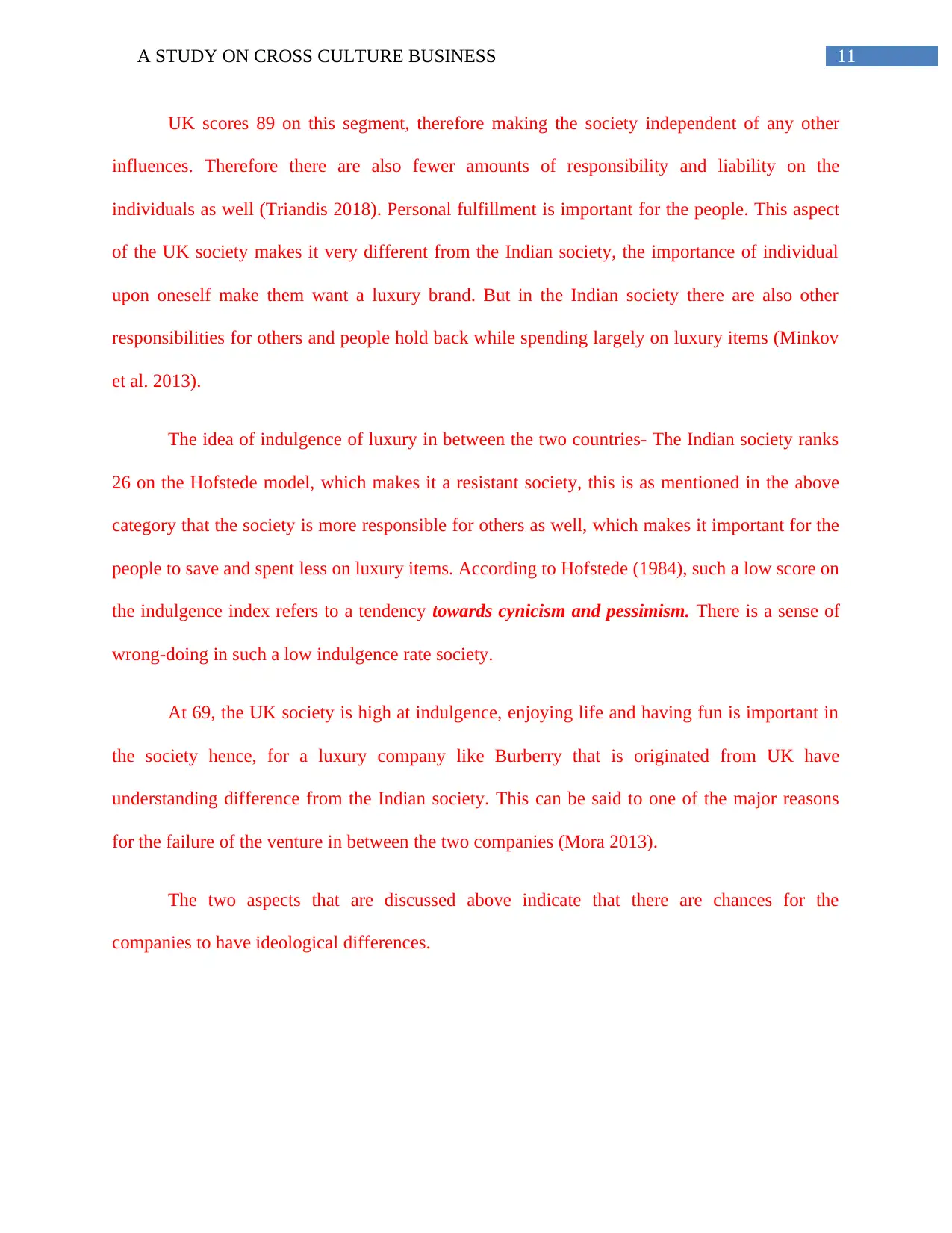
11A STUDY ON CROSS CULTURE BUSINESS
UK scores 89 on this segment, therefore making the society independent of any other
influences. Therefore there are also fewer amounts of responsibility and liability on the
individuals as well (Triandis 2018). Personal fulfillment is important for the people. This aspect
of the UK society makes it very different from the Indian society, the importance of individual
upon oneself make them want a luxury brand. But in the Indian society there are also other
responsibilities for others and people hold back while spending largely on luxury items (Minkov
et al. 2013).
The idea of indulgence of luxury in between the two countries- The Indian society ranks
26 on the Hofstede model, which makes it a resistant society, this is as mentioned in the above
category that the society is more responsible for others as well, which makes it important for the
people to save and spent less on luxury items. According to Hofstede (1984), such a low score on
the indulgence index refers to a tendency towards cynicism and pessimism. There is a sense of
wrong-doing in such a low indulgence rate society.
At 69, the UK society is high at indulgence, enjoying life and having fun is important in
the society hence, for a luxury company like Burberry that is originated from UK have
understanding difference from the Indian society. This can be said to one of the major reasons
for the failure of the venture in between the two companies (Mora 2013).
The two aspects that are discussed above indicate that there are chances for the
companies to have ideological differences.
UK scores 89 on this segment, therefore making the society independent of any other
influences. Therefore there are also fewer amounts of responsibility and liability on the
individuals as well (Triandis 2018). Personal fulfillment is important for the people. This aspect
of the UK society makes it very different from the Indian society, the importance of individual
upon oneself make them want a luxury brand. But in the Indian society there are also other
responsibilities for others and people hold back while spending largely on luxury items (Minkov
et al. 2013).
The idea of indulgence of luxury in between the two countries- The Indian society ranks
26 on the Hofstede model, which makes it a resistant society, this is as mentioned in the above
category that the society is more responsible for others as well, which makes it important for the
people to save and spent less on luxury items. According to Hofstede (1984), such a low score on
the indulgence index refers to a tendency towards cynicism and pessimism. There is a sense of
wrong-doing in such a low indulgence rate society.
At 69, the UK society is high at indulgence, enjoying life and having fun is important in
the society hence, for a luxury company like Burberry that is originated from UK have
understanding difference from the Indian society. This can be said to one of the major reasons
for the failure of the venture in between the two companies (Mora 2013).
The two aspects that are discussed above indicate that there are chances for the
companies to have ideological differences.
⊘ This is a preview!⊘
Do you want full access?
Subscribe today to unlock all pages.

Trusted by 1+ million students worldwide
1 out of 25
Related Documents
Your All-in-One AI-Powered Toolkit for Academic Success.
+13062052269
info@desklib.com
Available 24*7 on WhatsApp / Email
![[object Object]](/_next/static/media/star-bottom.7253800d.svg)
Unlock your academic potential
Copyright © 2020–2025 A2Z Services. All Rights Reserved. Developed and managed by ZUCOL.





